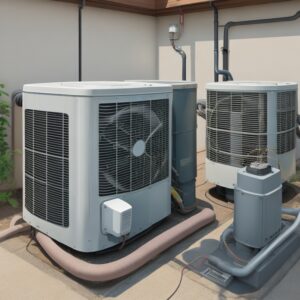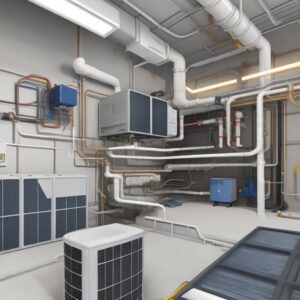Your home’s heating, ventilation, and air conditioning system, commonly known as HVAC, is the unseen hero of household comfort. It quietly works behind the scenes to ensure that the temperature is just right, the air is fresh, and humidity is balanced. By mastering temperature control, enhancing airflow, and filtering out impurities, the HVAC system creates an optimal environment for both living and working.
Understanding the HVAC Components

A well-functioning HVAC system comprises numerous parts, each playing a big role in temperature control and air quality. Let’s examine these components more closely:
The furnace is at the heart of any heating system, typically powered by gas, electric, or oil. It heats air which is then pushed through the ductwork to be distributed throughout the home.
Heat Pumps. These versatile units operate by transferring warmth from one place to another, providing heating in the winter and cooling in the summer months. Unlike traditional furnaces, they do not generate heat but rather move it, making them a highly efficient alternative.
Boilers heat water to deliver warmth through radiators or underfloor heating systems. They can be a part of a hydronic system that offers a gentle and even distribution of heat.
The network of ducts hidden in your walls and ceilings is responsible for delivering warm or cool air to different rooms. The design and installation of the ductwork influence the system’s efficiency and the evenness of temperature distribution.
Vents ensure that the conditioned air reaches every corner of the house. They are also crucial for returning air back to the HVAC unit to be reconditioned, maintaining constant circulation.
Central to maintaining indoor air quality, filters capture dust, pollen, and other airborne particulates, preventing them from circulating throughout your home.
The AC compressor acts as the system’s pump, moving refrigerant through the coils to cool the air. It pressurizes the refrigerant, enabling it to capture and release heat effectively.
Coils and Refrigerants. As the refrigerant moves through the coils, it changes from a gas to a liquid, absorbing heat from the indoor air. The cold coils then cool the air as it passes over them.
Blower Fans. These components move air over the AC’s evaporator coils and then force the cooled air through the ductwork and into the various rooms of your home.
The Science of Temperature Control
The ability to control the temperature within our indoor environments is not just a modern luxury; it’s a complex scientific process rooted in the laws of thermodynamics. Effective HVAC systems leverage these principles to move heat energy in a way that achieves our desired climate conditions.
In the winter, HVAC systems work to introduce warmth into cooler indoor environments, and conversely, in the summer, they remove excess heat to cool the indoors. This is made possible by the use of various energy forms, including electricity and natural gas, which power the components responsible for heating and cooling.
A thermostat serves as the command center for temperature regulation. It monitors the ambient temperature of the space using sensors and compares it with the user’s set preferences. When the internal temperature deviates from the desired setting, the thermostat signals the HVAC system to activate its heating or cooling cycle. It’s essentially the communicator between you and the complex mechanisms of your HVAC system, ensuring that your comfort needs are continuously met.
Modern thermostats have advanced far beyond the simple dials or slide controls of the past. Programmable thermostats can adjust temperatures according to daily schedules, and smart thermostats take it a step further with features such as learning algorithms that adjust settings based on usage patterns and the ability to control home climates remotely via smart devices.
Zoning systems represent another advancement in the quest for customized temperature control—particularly beneficial in larger homes or buildings where a one-size-fits-all approach to heating and cooling may lead to inefficiencies or discomfort. Zoning divides a property into multiple areas or “zones,” each with its own dedicated thermostat. These individual thermostats control separate dampers within the ductwork to regulate and direct airflow precisely where it’s needed. The result is a tailored indoor climate for different areas, maximizing comfort and energy efficiency. For instance, a rarely used guest room can be set to a different temperature than the main living area, or the upstairs bedrooms can remain cooler at night while keeping the downstairs living space warmer.
The practical applications of thermodynamics within HVAC systems don’t end here. Advances in technology continue to refine the interplay between energy, heat transfer, and temperature control to create smarter, more efficient systems. From heat pumps that work by moving existing heat rather than generating new heat, to systems that can seamlessly adapt to outside weather conditions, the science of temperature control has become an essential consideration in the design and operation of building environments.
Air Quality and Health

The importance of breathing clean air in our homes and workplaces cannot be overstated. Indoor air quality plays a big role in our health and overall well-being. HVAC systems have the dual task of regulating temperature and ensuring that the air we breathe is free of harmful contaminants. Various types of filters are at the frontline of this defense.
Standard filters in HVAC systems trap dust, pet dander, and larger particulate matter, keeping pollutants from recirculating through our air. For those who require a more advanced level of air purification, such as individuals with allergies, asthma, or other respiratory conditions, high-efficiency particulate air, or HEPA, filters become necessary. These sophisticated filters are designed to capture a minimum of 99.97% of dust, pollen, mold, bacteria, and airborne particles with a size of 0.3 microns (µm). HEPA filters thus significantly reduce the number of irritants in the air.
But filtration alone is not the only consideration. The humidity level of the indoor air also has a profound impact on both comfort and health. Air that is too humid can create a breeding ground for mold and mildews, leading to poor air quality and potential health problems. Dehumidifiers can help mitigate this by removing excess moisture from the air, protecting structural integrity, and inhibiting the growth of allergens. Air that is too dry can cause discomfort in the form of dry skin, irritable airways, and can even make people more susceptible to respiratory viruses. Humidifiers add moisture to the air, creating more hospitable and healthful living conditions.
Managing air quality also involves the regular upkeep of the HVAC system itself. Accumulated dust and debris within the ducts or on components can lead to reduced efficiency and to the circulation of polluted air. Routine maintenance—including professional inspection, cleaning of the ductwork, and replacing filters regularly—is essential to ensure that the air remains clean. In fact, many HVAC service providers recommend changing filters as frequently as every three months, more often if the household includes pets, smokers, or individuals with allergies.
Beyond the basic steps of maintenance, there are additional HVAC options to consider for enhancing air quality. UV-C air purifiers, for example, utilize ultraviolet light to kill bacteria, viruses, and other pathogens as air passes through the HVAC system. This technology, paired with proper filtration and humidity control, can contribute to an even healthier indoor environment, potentially reducing the likelihood of disease transmission and improving overall respiratory health.
Innovative HVAC Technologies
Today’s HVAC systems employ advanced technologies to boost efficiency and performance. Smart thermostats allow you to control your home’s climate remotely and learn your preferences to save energy. Eco-friendly features in newer systems also capitalize on energy efficiency, reducing utility bills and environmental impact. Germicidal UV lamps can be added to HVAC units, targeting microorganisms like bacteria and viruses, improving the healthfulness of circulated air.